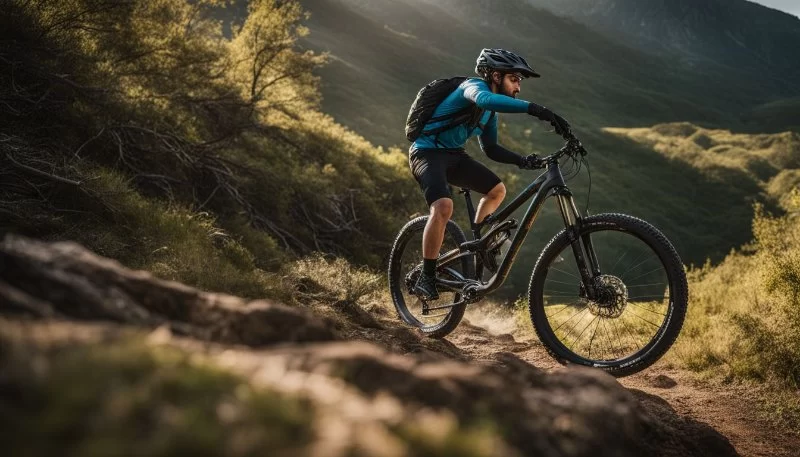- importance-of-mountain-biking-gear
- helmet-technology-for-technical-trails
- protective-gear-beyond-the-helmet
- bike-suspension-and-tire-considerations
- hydration-and-nutrition-tools
- navigation-lighting-and-repair-tools
- case-study-real-trail-gear-experiences
- where-to-get-your-gear
1. Why Proper Gear Is Crucial for Technical Trail Riding
Riding technical mountain biking trails isn't just about skill—it’s about preparation. Whether you're navigating steep descents, rock gardens, or root-heavy switchbacks, the right gear can be the difference between an epic ride and a dangerous one. Technical trails demand more from both rider and equipment. Riders who underestimate the role of proper gear often find themselves facing mechanical issues, fatigue, or worse, injury.
Unlike leisurely forest rides, technical routes test your endurance, reflexes, and resilience. To perform your best, you need to equip yourself with tools that match the trail’s demands. Sites like Pine Cliff Resort recommend specific gear tailored to varying terrain difficulty, giving both beginners and veterans a safer and more enjoyable experience.
2. Helmet Technology for Technical Trails
A helmet is non-negotiable, but not all helmets are created equal—especially for technical trails. Advanced features like MIPS (Multi-directional Impact Protection System), extended rear coverage, and adjustable visors are essentials when you're bombing down narrow descents.
When mountain biking through trails with rock drops and unexpected corners, your helmet needs to do more than pass basic safety tests. It needs to fit snugly, manage sweat, and provide protection for back-of-head impacts—common in technical crashes. Some riders prefer full-face helmets on downhill routes, offering extra protection at the cost of ventilation. Choose based on your typical terrain and comfort tolerance.
3. Protective Gear Beyond the Helmet
Many riders ignore body protection until they experience their first bad fall. Don’t make that mistake. Knee and elbow pads are lifesavers—literally. Look for lightweight yet impact-absorbing materials like D3O or soft-shell pads that harden on impact.
For extremely rugged trails, riders may add chest protectors, spine protectors, and padded gloves. The goal isn’t to armor up like a knight but to enhance safety while retaining agility. A good fit is key: loose gear shifts around and can actually cause more harm in a fall. Trail veterans at Pine Cliff Resort emphasize that the extra confidence gear provides often translates to better performance on the trail.
4. Optimizing Suspension and Tires for Technical Rides
Technical riding isn’t just hard on you—it’s hard on your bike. If you’re not using a full-suspension mountain bike, at least ensure your front suspension fork is properly tuned. Look for adjustable rebound and compression settings to fine-tune your ride feel.
Your tires matter just as much. Tubeless setups offer lower pressure and better traction without the fear of pinch flats. Choose tires with aggressive tread patterns—like Maxxis Minion or Schwalbe Magic Mary—for control in loose or wet terrain. Keep a pump or CO₂ inflator handy for on-the-fly adjustments. The wrong tire pressure can make a good ride feel punishing.
5. Hydration and Nutrition on Demanding Trails
It’s easy to underestimate how much energy technical trails drain from your body. Short climbs and constant braking put unique stress on your muscles. That’s why hydration packs—not water bottles—are preferred. They offer hands-free drinking and can carry tools, snacks, and even an emergency blanket.
Look for packs with ventilated back panels and quick-access compartments. Include energy gels, electrolyte tablets, or bars in your loadout. In areas like the backcountry trails near Pine Cliff Resort, refueling options are limited. Always carry more water and food than you think you’ll need.
6. Navigation, Lighting, and Field Repairs
Technical trail systems are often deep in the woods or the mountains. Phone signals drop off quickly, and trail signs can be ambiguous. GPS-enabled bike computers, such as the Garmin Edge series, help you stay on track. Bring a backup paper map, especially on unfamiliar routes.
Lighting is another overlooked necessity. A late start or unexpected delay can turn your trail ride into a dusk descent. Handlebar-mounted or helmet-mounted lights with 800+ lumens are ideal. For repairs, never ride without a multitool, tire levers, spare tubes (even if tubeless), chain link, and pump. Pine Cliff Resort bike technicians recommend pre-checking your gear before every outing—and carrying essentials for trailside fixes.
7. Real Trail Gear Experiences That Made a Difference
Meet Trevor, an intermediate rider who took on one of Pine Cliff’s gnarlier black-diamond trails with only a basic cross-country setup. Halfway in, a rock punch blew out his tire, and he had no repair kit. After a long, walking descent, he upgraded: tubeless tires, knee guards, and a hydration vest. “It wasn’t just about comfort,” he says. “I gained confidence and actually improved my riding.”
Another rider, Amara, swears by her dropper seatpost and lightweight elbow pads. Her favorite quote? “The best gear is the stuff that makes you forget it’s there.” Her story—and others like it—underline the importance of gear that fits your ride style and body.
8. Where to Get Gear You Can Trust
High-quality mountain biking gear is an investment—but a worthwhile one. At Pine Cliff Resort, we partner with trusted brands and offer curated gear packages designed for different terrain difficulty levels. Whether you’re exploring beginner loops or eyeing double black routes, we guide you to gear that matches your trail goals.
Our staff includes seasoned riders who can advise on everything from suspension tuning to gear layering. The trails may challenge your body—but your equipment shouldn’t hold you back. Visit our center or explore our trusted partner recommendations to build a kit that works as hard as you do.







